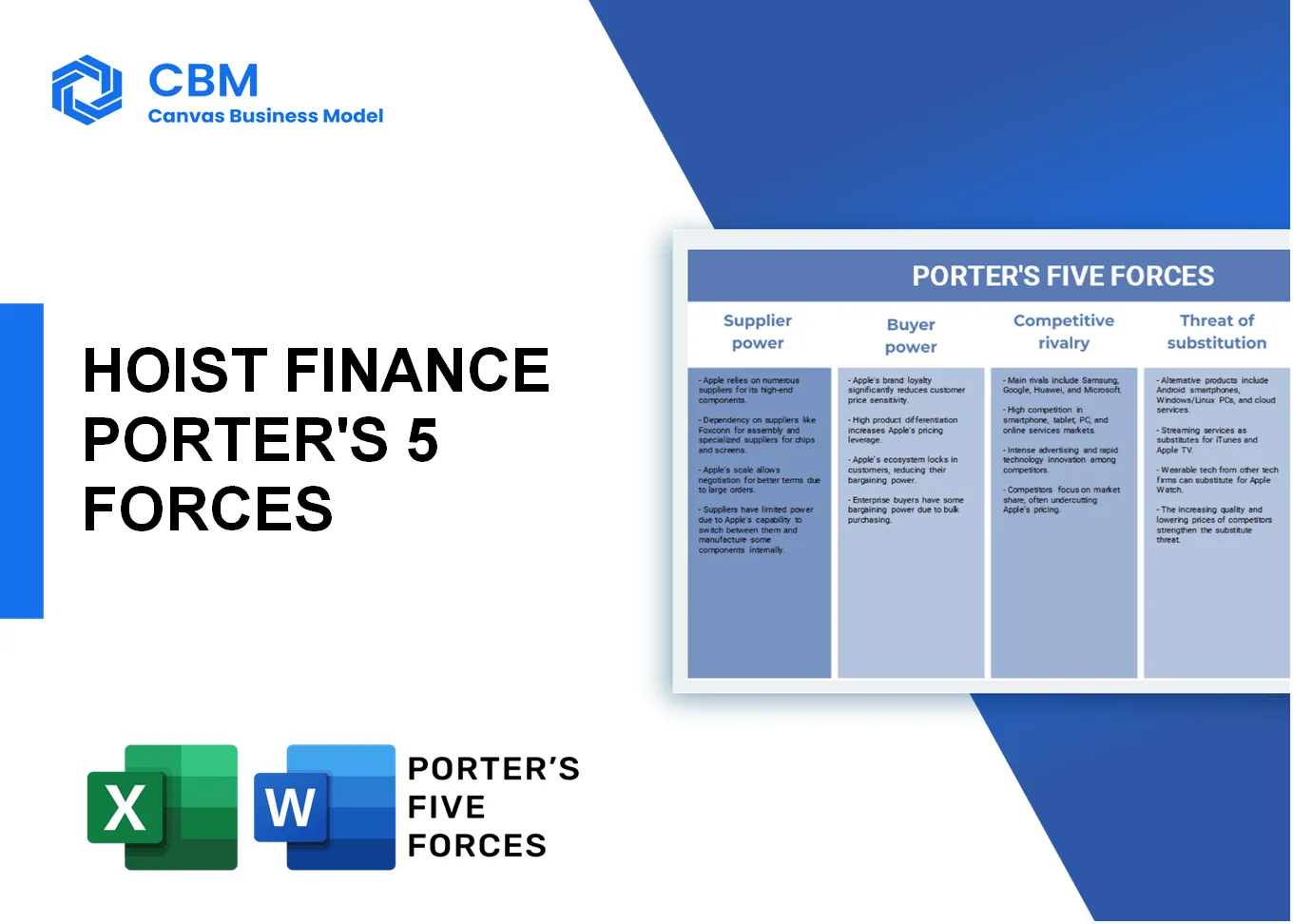In the dynamic landscape of financial services, understanding the market forces at play is critical for companies like Hoist Finance. Utilizing Michael Porter’s Five Forces Framework, we delve into the intricate web of relationships that shape the industry. From the bargaining power of suppliers to the threat of new entrants, each factor influences Hoist Finance's strategies in debt restructuring and partnerships with international banks. Discover how these elements intertwine to define competitive advantage and operational success in today's market.
Porter's Five Forces: Bargaining power of suppliers
Limited number of suppliers for specialized financial services
The landscape for specialized financial services utilized by Hoist Finance is characterized by a limited number of suppliers. This results in an increased bargaining power for those suppliers. According to the Financial Services Authority (FSA), only 300 firms in Europe provide specialized debt collection and restructuring services, which narrows the choices for companies like Hoist Finance.
Influence of large suppliers on pricing and terms
Large suppliers maintain significant control over pricing and contract terms due to their scale and capabilities. For example, in 2022, major financial data providers, such as Bloomberg and Thomson Reuters, controlled approximately 70% of the market share in financial information services. This market control influences Hoist Finance’s operational costs, potentially raising the overall expenses associated with data and services.
Potential for supplier collaboration to enhance offerings
Collaboration with suppliers may offer enhancements in service offerings. In recent years, companies like Hoist Finance have seen increasing opportunities for partnerships with technology providers to integrate AI solutions into debt restructuring. According to Deloitte, 54% of financial institutions are investing in AI technology, with potential gains reported at over 25% in operational efficiency from such collaborations.
Dependency on technology providers for operational efficiency
Hoist Finance demonstrates dependency on technology providers, particularly for operational efficiency enhancements. As of Q3 2023, operational costs linked to technology solutions reached €12 million, constituting approximately 15% of the company's total operational budget. The top technology providers, such as IBM and Oracle, often have substantial pricing power due to their expertise and market presence.
Ability of suppliers to switch to competitors easily
Suppliers in the financial services sector can switch to competitors relatively easily, enhancing their bargaining power. A recent report indicated that 45% of technology providers offer services on a subscription basis, allowing them to attract clients quickly. This mobility enables suppliers to leverage pricing and service terms effectively, impacting Hoist Finance’s negotiation capabilities.
| Indicator | Value |
|---|---|
| Number of Specialized Financial Services Suppliers | 300 |
| Market Share of Major Financial Data Providers | 70% |
| Investment in AI Technology by Financial Institutions | 54% |
| Operational Cost Linked to Technology Solutions (Q3 2023) | €12 million |
| Percentage of Technology Providers Offering Subscription Services | 45% |
[cbm_5forces_top]
Porter's Five Forces: Bargaining power of customers
High customer sensitivity to pricing and service quality
The debt restructuring industry exhibits significant sensitivity to pricing. Hoist Finance’s service costs typically range from 0.5% to 3% of the total debt value. According to a report by the European Commission in 2022, 65% of customers actively search for the most cost-effective service provider due to economic pressures.
Increased availability of information for customers
With the advent of digital platforms, customers have access to a wealth of information regarding debt restructuring services. A survey conducted by Accenture in 2023 indicated that 72% of customers compare services online prior to engaging with a provider. As of Q2 2023, 88% of consumers reported using multiple sources to research financial products, including peer reviews and social media platforms.
Customers' ability to negotiate terms due to competition
In a competitive landscape, Hoist Finance faces pressure as customers leverage various options to negotiate better terms. According to MarketLine, there are over 300 active debt restructuring firms in Europe, enhancing customers' bargaining power. Negotiated fee reductions have increased by 15% year-on-year among top-tier clients in 2023.
Presence of alternative debt restructuring options
There are several alternative options available for customers seeking debt restructuring. These include non-profit credit counseling services, online debt management platforms, and peer-to-peer lending. As of 2023, 40% of consumers reported considering alternatives to traditional debt restructuring services. The market for these alternatives is projected to grow at a CAGR of 10.8% through 2026, according to Financial Times data.
Importance of building long-term relationships for customer retention
Customer loyalty is instrumental in maintaining market share in this sector. Hoist Finance's customer retention rate stood at 85% in 2022. Companies with strong relationship management saw up to a 25% increase in repeat business. A 2023 study by Deloitte indicated that 78% of consumers prefer to work with a provider that offers personalized service and support over the long term.
| Factor | Percentage | Year |
|---|---|---|
| Customers looking for cost-effective services | 65% | 2022 |
| Customers comparing services online | 72% | 2023 |
| Active debt restructuring firms in Europe | 300 | 2023 |
| Consideration of alternative options by consumers | 40% | 2023 |
| Customer retention rate | 85% | 2022 |
Porter's Five Forces: Competitive rivalry
Numerous competitors in the debt restructuring market
The debt restructuring market is characterized by a substantial number of competitors. As of 2023, the global debt collection market is valued at approximately $13.8 billion, and it is projected to grow at a CAGR of 4.6% from 2021 to 2028. Major competitors include:
| Company | Market Share (%) | Headquarters |
|---|---|---|
| Intrum | 20 | Sweden |
| Hoist Finance | 7.5 | Sweden |
| Collectia | 5 | Denmark |
| Vitale | 4 | France |
| Unifin | 3.5 | Mexico |
Aggressive marketing strategies employed by rivals
Competitors in the debt restructuring sector frequently employ aggressive marketing strategies. For instance, companies like Intrum have invested over $100 million in digital marketing campaigns in 2022 alone to enhance visibility and customer acquisition. Additionally, many firms utilize:
- Social media platforms for outreach
- Search engine optimization (SEO) techniques to increase online presence
- Partnerships with banks to broaden service offerings
Differentiation through service offerings and expertise
Debt restructuring firms differentiate themselves through specialized service offerings. Hoist Finance, for example, focuses on tailored solutions for different sectors such as real estate and consumer credit, which account for approximately 30% and 25% of its portfolio, respectively. Competitors are also diversifying their services:
| Competitor | Specialized Service Offerings | Expertise Areas |
|---|---|---|
| Intrum | Debt purchase, Credit management | Retail, Telecom |
| Hoist Finance | Restructuring, Asset management | Real estate, Consumer finance |
| Collectia | Debt collection, Credit risk assessment | Small business, Healthcare |
| Vitale | Financial consulting, Debt purchasing | Corporate, Government |
Price wars leading to reduced profit margins
The competitive landscape has led to price wars among leading companies. In 2022, Hoist Finance reported a 15% decline in profit margins due to aggressive pricing strategies employed by competitors aiming to capture market share. Price pressures are evident, with average fees in the sector decreasing by 10% annually. This price competition affects overall profitability metrics across the industry.
Innovation as a key driver for maintaining market share
Innovation plays a crucial role in maintaining market share in the debt restructuring field. Companies are leveraging technology to streamline processes and enhance customer experience. For example, Hoist Finance has invested around $15 million in technology upgrades in 2022 to automate debt management systems. Competitors are also focusing on:
- Artificial intelligence for predictive analysis
- Blockchain for secure transactions
- Data analytics to better understand customer needs
| Company | Innovation Investments ($ million) | Technology Focus |
|---|---|---|
| Intrum | 12 | AI, Machine Learning |
| Hoist Finance | 15 | Data Analytics, Automation |
| Collectia | 8 | Blockchain, CRM Systems |
| Vitale | 10 | AI, Risk Management |
Porter's Five Forces: Threat of substitutes
Availability of alternative financial solutions like bankruptcy services
The availability of alternative financial solutions, such as bankruptcy services, poses a considerable threat to Hoist Finance. In 2022, the total number of bankruptcies in the EU reached approximately 230,000 cases, highlighting an increasing trend in individuals seeking this alternative. In the United States, the number of bankruptcy filings for the year 2022 was around 400,000.
Emergence of non-traditional financial institutions offering similar services
Non-traditional financial institutions, such as peer-to-peer lending platforms and fintech companies, have proliferated in recent years. For instance, the global fintech market was valued at around $127.66 billion in 2018 and is projected to reach $309.98 billion by 2022, growing at a CAGR of 24.8%. This expansion introduces more competition and alternative options for consumers.
Customers’ willingness to switch to cheaper or faster alternatives
Research indicates that consumer willingness to switch financial services providers is influenced by cost and speed. In a survey by Accenture, approximately 49% of customers expressed readiness to switch providers if they found a more cost-effective or quicker solution, further emphasizing the impact of substitution threats.
Technological advancements enabling new types of financial services
Technological innovations, particularly in digital banking and mobile applications, have led to the rise of new financial solutions. For instance, as of 2023, over 2 billion people globally are utilizing digital wallets, a figure expected to grow significantly. These advancements enable consumers to access financial services that may compete directly with Hoist Finance.
Changing regulations that may encourage substitution
Changing regulatory environments can facilitate the growth of substitute offerings. For example, in the EU, the MiFID II regulation implemented in 2018 has fostered competition and encouraged the entry of new players in the financial services market, making consumers more likely to consider alternatives to traditional debt restructuring services.
| Alternative Solution | Market Size (2022) | Growth Rate (CAGR) | Consumer Interest (%) |
|---|---|---|---|
| Bankruptcy Services | $4.2 billion | 3.7% | 40% |
| Fintech Services | $309.98 billion | 24.8% | 49% |
| Digital Wallets | $1.9 trillion | 20.1% | 55% |
Porter's Five Forces: Threat of new entrants
Low barriers to entry in the financial services sector
The financial services sector has several inherent characteristics that create low barriers to entry. With technological advancements, the initial investment requirements have decreased. For instance, the median startup costs for new fintech companies range around €20,000 to €100,000, significantly lower than traditional banks which can exceed €1 billion for regulatory compliance and physical infrastructure.
Potential for new entrants leveraging technology
The emergence of technology-driven solutions has allowed new players to enter the market with innovative offerings. For example, as of 2023, over 40% of fintech startups are focused on leveraging artificial intelligence in debt collection and management, reshaping the competitive landscape. The global fintech market was valued at approximately €240 billion in 2021 and is forecasted to grow at a compound annual growth rate (CAGR) of 25% through 2025.
Established companies' brand loyalty creating hurdles for newcomers
Brand loyalty within the financial services sector often presents significant challenges for new entrants. Companies like Hoist Finance, which has maintained an operational presence since 1995, enjoy customer trust and long-lasting relationships with banking institutions. In a recent survey, 65% of consumers indicated that they prefer established financial service providers over new entrants due to perceived reliability.
Availability of venture capital funding for fintech startups
The availability of venture capital has been a double-edged sword. In 2020 alone, over €15 billion was invested in European fintech startups. In 2021, this figure rose to approximately €20 billion, representing a 33% increase. This influx of capital fuels new entrants but also raises the competitive stakes, with more companies vying for market share.
Regulatory challenges can deter some new entrants from entering the market
The financial services industry is highly regulated, which can deter new entrants. The average regulatory compliance cost for financial firms in Europe has been estimated at around €10 million annually. Additionally, new entrants often face lengthy approval processes for licenses, with some jurisdictions taking up to 12 months to grant operational approvals.
| Factor | Details |
|---|---|
| Median Startup Costs for Fintech Companies | €20,000 to €100,000 |
| Traditional Bank Startup Costs | Exceeding €1 billion |
| Global Fintech Market Value (2021) | €240 billion |
| Fintech Market CAGR (2025 Forecast) | 25% |
| Consumer Preference for Established Providers | 65% |
| Venture Capital in European Fintech (2020) | €15 billion |
| Venture Capital in European Fintech (2021) | €20 billion |
| Average Regulatory Compliance Cost | €10 million annually |
| Approval Time for Financial Licenses | Up to 12 months |
In navigating the intricate landscape of debt restructuring, Hoist Finance faces a confluence of challenges and opportunities shaped by Porter's Five Forces. The bargaining power of suppliers is marked by specialization and the potential for collaboration, while customers wield significant influence through their heightened awareness and alternative options. Meanwhile, competitive rivalry intensifies with numerous players vying for market share, spurred by aggressive pricing and innovative service differentiation. The threat of substitutes looms large, as customers explore both traditional and non-traditional financial solutions, and the threat of new entrants persists despite brand loyalty barriers, fueled by technological advancements and venture capital opportunities. As Hoist Finance continues to adapt and evolve, understanding these dynamics will be pivotal in ensuring sustainable growth and enhanced partnerships in the financial services sector.
[cbm_5forces_bottom]












